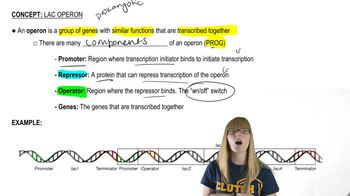Erythritol, a natural sugar abundant in fruits and fermenting foods, is about 65 percent as sweet as table sugar and has about 95 percent fewer calories. It is 'tooth friendly' and generally devoid of negative side effects as a human consumable product. Pathogenic Brucella strains that catabolize erythritol contain four closely spaced genes, all involved in erythritol metabolism. One of the four genes (eryD) encodes a product that represses the expression of the other three genes. Erythritol catabolism is stimulated by erythritol. Present a simple regulatory model to account for the regulation of erythritol catabolism in Brucella. Does this system appear to be under inducible or repressible control?
Table of contents
- 1. Introduction to Genetics51m
- 2. Mendel's Laws of Inheritance3h 37m
- 3. Extensions to Mendelian Inheritance2h 41m
- 4. Genetic Mapping and Linkage2h 28m
- 5. Genetics of Bacteria and Viruses1h 21m
- 6. Chromosomal Variation1h 48m
- 7. DNA and Chromosome Structure56m
- 8. DNA Replication1h 10m
- 9. Mitosis and Meiosis1h 34m
- 10. Transcription1h 0m
- 11. Translation58m
- 12. Gene Regulation in Prokaryotes1h 19m
- 13. Gene Regulation in Eukaryotes44m
- 14. Genetic Control of Development44m
- 15. Genomes and Genomics1h 50m
- 16. Transposable Elements47m
- 17. Mutation, Repair, and Recombination1h 6m
- 18. Molecular Genetic Tools19m
- 19. Cancer Genetics29m
- 20. Quantitative Genetics1h 26m
- 21. Population Genetics50m
- 22. Evolutionary Genetics29m
12. Gene Regulation in Prokaryotes
Lac Operon
Problem 16e
Textbook Question
In the lac operon, what are the likely effects on operon gene transcription of the mutations described in a–e?
Mutation of the CAP binding site of the lac promoter
 Verified step by step guidance
Verified step by step guidance1
Understand the lac operon: The lac operon is a group of genes in *E. coli* that are involved in lactose metabolism. It is regulated by the interaction of proteins with specific DNA sequences, including the CAP binding site, which is crucial for transcription activation in the presence of low glucose levels.
Identify the role of the CAP binding site: The CAP binding site is located upstream of the lac promoter. It is the binding site for the catabolite activator protein (CAP), which, when bound to cyclic AMP (cAMP), enhances RNA polymerase binding to the promoter, increasing transcription of the operon.
Analyze the mutation: A mutation in the CAP binding site would likely disrupt the binding of the CAP-cAMP complex to the DNA. This would impair the ability of CAP to enhance RNA polymerase binding, reducing the transcription of the lac operon genes, especially under conditions of low glucose.
Consider the physiological context: In the absence of glucose, cAMP levels are high, and CAP-cAMP normally binds to the CAP site to activate transcription. If the CAP binding site is mutated, this activation cannot occur, leading to reduced transcription even when lactose is present.
Summarize the likely effect: The mutation in the CAP binding site would result in decreased transcription of the lac operon genes, as the operon would not be efficiently activated in low glucose conditions, regardless of lactose availability.
 Verified video answer for a similar problem:
Verified video answer for a similar problem:This video solution was recommended by our tutors as helpful for the problem above
Video duration:
3mPlay a video:
Was this helpful?
Key Concepts
Here are the essential concepts you must grasp in order to answer the question correctly.
Lac Operon
The lac operon is a set of genes in E. coli that are involved in the metabolism of lactose. It consists of structural genes (lacZ, lacY, and lacA) and regulatory elements that control their expression. The operon is typically off when lactose is absent and is activated in the presence of lactose, allowing the bacteria to utilize this sugar as an energy source.
Recommended video:
Guided course

Lac Operon Overview
CAP Binding Site
The CAP (catabolite activator protein) binding site is a regulatory sequence located near the lac promoter. When glucose levels are low, CAP binds to this site, enhancing the binding of RNA polymerase to the promoter and increasing transcription of the lac operon. Mutations in this site can disrupt CAP binding, leading to reduced transcription of the operon.
Recommended video:
Guided course

Lac Operon Regulation
Transcription Regulation
Transcription regulation refers to the mechanisms that control the rate of gene expression. In the context of the lac operon, this involves both positive regulation by CAP and negative regulation by the lac repressor. Mutations affecting these regulatory elements can significantly alter the transcription levels of the operon, impacting the cell's ability to metabolize lactose.
Recommended video:
Guided course

Eukaryotic Transcription
Related Videos
Related Practice
Textbook Question
536
views


